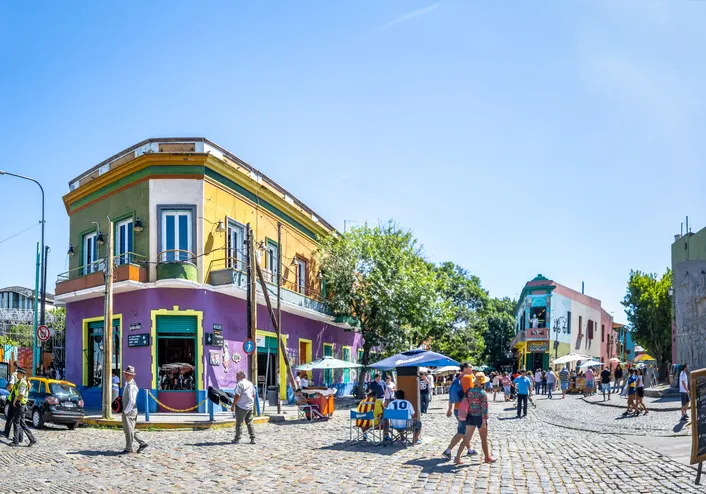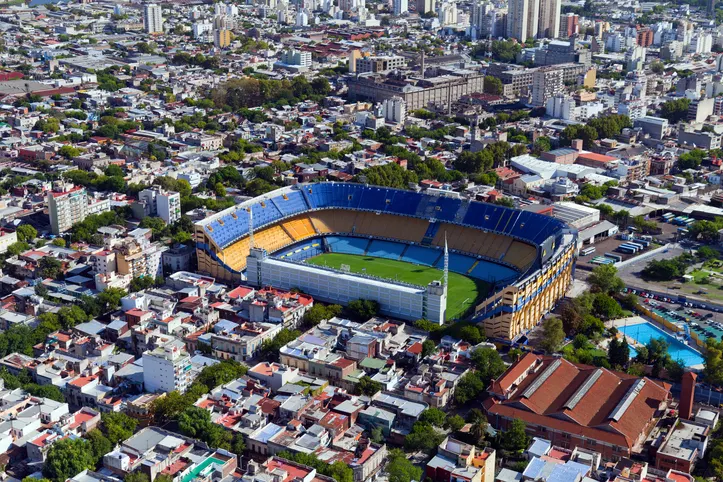Buenos Aires, the capital of Argentina, was once adored as the crown jewel of South America—a beacon of hope accepting tourists and immigrants from all over the world. Sadly, in the last decade, Argentina has fallen on hard times economically, with surging inflation rates well over 100% annually.
And yet, despite these financial struggles, the city and its residents have proven resilient. They are prideful, and they welcome visitors and expats alike with open arms because while some of the city’s grand splendor has dimmed slightly of late, locals are warm and want to share their home and their culture. While financial troubles will come and go, the "Paris of South America" will always remain.
How to Move Out of the U.S.
How to Move Out of the U.S.
In all sorts of beautiful, welcoming, culturally rich, saner places around the world, you can live well from $2,000 a month (all in, housing included). Sign up for our free daily IL Postcards e-letter and we’ll immediately send you a free report on the WORLD’S # 1 RETIREMENT HAVEN— plus 9 more spots you should have on your radar. Each day, you’ll earn about the best places to move to, retire, travel, buy real estate, and enjoy a good life for less, overseas.
By submitting your email address, you will receive a free subscription to IL Postcards and special offers from International Living and our affiliates. You can unsubscribe at any time, and we encourage you to read more about our Privacy Policy.
Originally founded in 1536, the city of Buenos Aires, or BsAs (abbreviated in Spanish), eventually fell to local indigenous tribes. Eventually, the Spanish returned to re-establish the city in 1580. At the time, much of the Spanish’s attention was on the regions of what is now modern-day Peru through Mexico, as gold and silver were more abundant in these areas of the New World. Lima’s shadows, Buenos Aires, grew, eventually becoming one of the great examples of a modern metropolitan city.
Today, you can see signs of the architectural influence not only of the Spanish but of the artisans Argentina welcomed from all over Europe following its independence from Spain in 1816. Even English influence can be spotted, as England was one of the country’s greatest allies (the now nearly defunct railway system was almost entirely built by the British).
Buenos Aires has a metro population of nearly 15.5 million people and an official city population of around 3 million.
Traveling to Buenos Aires

The best time to visit Buenos Aires is during the country’s spring and autumn seasons (ideally October-November and then March-April). The summer months of December and January are not only hot (daily regular temperatures averaging well into the 90s) but, more importantly, humid. This humidity can make the city quite uncomfortable at this time of year—think summertime in Florida. Additionally, temporary power outages in the city are common with the surge in air conditioning usage.
On the flip side, the winter months of June through August are chilly, with nighttime temperatures dipping into the low 30s. While it generally doesn’t snow in the city (the last recorded snowfall in Buenos Aires was in July 2007), low 40s and rain are common, so for travel purposes, it’s best to shoot for spring or fall.
In recent years, there have not been as many direct flights into Buenos Aires as there once were, due largely to the country's current economic situation. However, there are still daily non-stop flights from Atlanta, Miami, Dallas, New York, and even Seattle and Washington, D.C.
If these non-stop flights are too pricey, there are plenty of one-stop flights laying over in Bogota, Colombia, and Santiago, Chile. Several South American airlines service BsAs, but when flying from the United States, your best bet in terms of comfort and staying on schedule would be to fly Delta or American Airlines.
If traveling from Europe, there are non-stop flights from Madrid, Barcelona, Paris, Rome, and Frankfurt, although Madrid sees upwards of four non-stop flights a day. Iberia, Air Europe, ITA Airways, and KLM are some of the airlines that fly direct.
Buenos Aires is serviced by two airports. Ezeiza International Airport (EZE) is the main airport and the one you will likely fly into. However, if you have a connecting flight departing from another South American country, you may land at Aeroparque Internacional Jorge Newbery (AEP). EZE is further away from the city center and will take a 40-minute taxi ride. From the airport, you can either hire a driver after walking past customs or hire an Uber. AEP is right next to the city; the drive may take as little as 10 minutes, depending on where you are staying. Uber is the best option here and will likely cost you under $5.
Retire in Buenos Aires
There are no limitations to what you can do in Buenos Aires. In terms of activities in Latin America, few metropolitans can compete with what is offered in the heart of Argentina. Want to see a concert? The city sees the largest touring acts stop by regularly. Enjoy reading? There are more books per capita in Buenos Aires than in any other city in the world (with some dedicated exclusively to English readers). Want to go for a bike ride? Bike rental stations are scattered throughout the city, with most roads offering dedicated bike lanes protected by cement curbs to prevent cars from accidentally drifting into the lanes.
Public transportation is both excellent and incredibly affordable, meaning owning a car is entirely optional. The subway metro system runs throughout the city, and where it doesn’t go, a well-stocked bus system picks up the slack. Everything is paid for using a SUBE card purchased from local kiosks (although the best spot to buy one is when arriving at the airport). When converted to dollars, you’re paying only a couple of pennies per subway ride—It’s that cheap.
Uber and the local Cabify app offer easy options if you’d rather avoid waiting at stations, and these are also extremely affordable. A 40-minute ride to the airport using Uber will likely cost you no more than $15 (Cabify generally costs less).
There is a different neighborhood to call home based on your personal tastes. Buenos Aires, or Ciudad Autónoma de Buenos Aires (CABA, when filling out tourist or immigration paperwork to help differentiate it from the wider Buenos Aires province), is home to 48 barrios. Each of these neighborhoods is unique in its own rights. Palermo and Recoleta are two of the wealthier communities where expats and tourists congregate amongst upscale shopping boutiques, coffee shops, artisan gelato displays, and weekend markets, all while overlooked by pristine representations of European architecture.
While Recoleta offers European splendor, and Palermo Soho and Hollywood offer chic shops, other neighborhoods, like San Telmo and La Boca, offer reflections of the city’s working-class past—a city built not only by the Spanish but by artisans from around Europe.
San Telmo showcases a bohemian vibe (and an exceptional Sunday market). Puerto Madero is a new-age neighborhood built along the river. The steel and glass highrises reflect the water below as boats remain docked, preparing to take to the open seas. This neighborhood does lose some of the quintessential Buenos Aires vibe as it feels more like a Florida coastal city than a European transplant, but if that’s what you’re searching for, you’ll find it right here.
You will find various visa options to consider. Argentina allows guests to stay for up to 90 days (with another 90-day extension); however, you can leave the country and return and receive a shiny new 90 days. Some expats regularly perform border runs, often to Colonia del Sacramento, the Uruguay coastal city sitting on the other side of an hour-long ferry ride.
However, if you opt for the border run, you should spend a bit more time (a week or two, perhaps) exploring neighboring countries. Argentina also has a flat visa overstay fee, so whether you overstay by a day or three years, it’s the same flat fee (roughly $40). Expats not interested in traveling every 90 days often opt for this, as it is easy and extremely affordable. Just make sure to pay the fee before leaving, otherwise, you’ll have problems returning.
Work visas do exist, although they are not recommended. Due to the massive inflation and low wages in Argentina, earning the local currency wouldn’t make much sense at all. There is also an Argentina retirement visa, which is good for a year and can be renewed for up to three years. This can be a ticket to citizenship in Argentina if that is something you are interested in. A digital nomad visa is available, although it’s uncommon.
Lifestyle in Buenos Aires

You get what you put into Buenos Aires. If you want an exciting life, visiting some of the best steak restaurants in the world, taking in stage play productions at truly beautiful theaters, and regularly hitting up the town for vino and cocktails, you can do exactly that. There’s always a late-night activity going on and something to do.
Yet, suppose you want to relax, take your time, sip a morning espresso from a local café and people-watch, take an occasional tango lesson, and go for long walks under tree-lined pedestrian avenues. In that case, you have that at your disposal as well.
With a city the size of Buenos Aires, there’s a lifestyle for everyone. That also means you can live a relaxing life one week and a busy one the next.
There are also plenty of day or weekend excursions to enjoy. Colonia del Sacramento (simply referred to as Colonia) in Uruguay is a wonderful trip full of bed and breakfasts, Spanish seafood, and old-world charm, while Mendoza is the Napa Valley of Argentina and the perfect destination for a charming long weekend.
Things to Do in Buenos Aires

Take in a tango show. There are dozens of tango shows around town. Some include dinner, others you sit back and watch the entertainment.
Enjoy a live production. Teatro Colon is a world-class theater and a true spectacle. This destination is a must, even if you’re not a fan of live performances. Besides, you can always wait for the theater to announce its next “Star Wars” presentation with a live orchestration accompaniment.
The Jardin Japones is one of the largest Japanese gardens in the world (outside of Japan). You’ll be amazed at how quiet the gardens are, especially surrounded by such a hectic city. It is the perfect location to recharge your batteries and enjoy tea.
Cemeterio de la Recoleta is a miniature city of mausoleums in the heart of one of the most upscale neighborhoods. It’s worth at least one visit (go during a weekday, as it is incredibly busy during the weekends). Eva Perón’s final resting place is here. Beyond Madonna playing Eva in the film Evita, Eva Perón played an important role in Argentina’s history.
If you’re looking for something a little bit outside of the city, visiting the city of Tigre is a must. You can take the metro out to Tigre, or catch an Uber. However, it’s a beautiful location to take in riverboat rides, enjoy world-class gelato, and escape the hustle and bustle of the city
No stay in Buenos Aires would be complete without taking in at least one futbol game. The city has numerous teams, but the two main ones are Boca Juniors and River Plate. Think of this as the NFL’s Oakland Raiders vs. the San Francisco Giants (back when the Raiders were in Oakland). Boca is a working-class neighborhood, while River is more high-end. Both stadiums offer different experiences but do note that you can’t just buy tickets. All tickets are owned by club members, which means you basically have to buy tickets from these members. Options to do this are available through travel platforms like Airbnb and TripAdvisor.
Cost of Living in Buenos Aires
Argentina’s economy has been, in short, nothing less than a disaster over the past decade. Surging inflation, currency devaluations, problems with soybean and wine productions, and beef export freezes. If it weren’t for Venezuela, Argentina would by far have the biggest floundering economy in the Western Hemisphere. The situation makes it difficult for anyone earning in the local currency. Still, for anyone earning in dollars, euros, or any other foreign, stable currency, it makes Argentina, specifically Buenos Aires, one of the best value destinations in the world.
You’ll be hard-pressed to find another metropolitan city like BsAs anywhere else in the world with the same resources and quality of life for such an affordable price. It is by far the biggest budget destination in the region. When residents from Brazil, Paraguay, and Peru visit Argentina to take advantage of the cheaper economy, you know it’s an affordable destination to possibly call home.
Upcoming elections may eventually impact this, although it’s impossible to forecast at this point, especially as there have been numerous presidential elections since the economic downturn began, and nothing has helped. So, for now, Buenos Aires remains one of the most affordable, and desirable locations to retire in all of South America
Here’s a sample of a lower-end budget for monthly expenses:
| Rent (furnished, two-bedroom apartment) | $500+ |
| Electricity | $40-$60 |
| Water | >$10 |
| Gas | $10 |
| Household help | $3 an hour (although you can/should consider paying more) |
| Internet | $10 |
| Cellphone | $2 |
| Cable/Pay TV (premium) | $50 |
| Private Healthcare for two | $100 |
| Transportation | $30 |
| Groceries | 300 |
| Entertainment | $200 |
| Miscellaneous | $50 |
| Monthly Total | $1045+ |
Safety in Buenos Aires
As is the case with any large city, crime does exist. However, crime, especially in popular expat communities, differs from that of U.S. major cities such as Miami, New York, or Dallas. Firearms are difficult to come by, and while locals can purchase them, the hoops they have to jump through, as well as the extremely high costs, make any firearm-related crime truly rare.
Petty crimes, such as stolen cell phones and wallet snatching, are the only real forms of crime you need to be mindful of. Basically, don’t pull your cell phone or wallet out in a crowded area, don’t hang your purse from the back of a chair on an outside patio with free access to the street, and wear both straps on your backpack. In short, if you’re mindful of your surroundings, you shouldn’t have any issues with petty crime, which means you likely won’t have any issues with any crime in Buenos Aires.
How to Move Out of the U.S.
How to Move Out of the U.S.
In all sorts of beautiful, welcoming, culturally rich, saner places around the world, you can live well from $2,000 a month (all in, housing included). Sign up for our free daily IL Postcards e-letter and we’ll immediately send you a free report on the WORLD’S # 1 RETIREMENT HAVEN— plus 9 more spots you should have on your radar. Each day, you’ll earn about the best places to move to, retire, travel, buy real estate, and enjoy a good life for less, overseas.
By submitting your email address, you will receive a free subscription to IL Postcards and special offers from International Living and our affiliates. You can unsubscribe at any time, and we encourage you to read more about our Privacy Policy.













